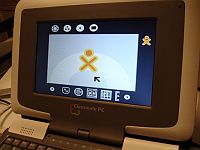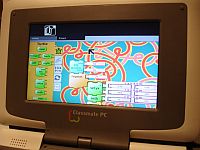I am Aaron Kaplan. I recently got a Classmate into my hands (the old one, not the new Intel 2Go next version of the Classmate). Now if the XO laptop is rare in Europe... the Classmate is even rarer.
As a member of OLPC Austria, what is our first idea? Right! A great chance to install our favorite operating system from One Laptop Per Child. So Nadja Igler and me set out to go where no OLPC geek has gone before. We set out on a long fearless journey to free the Classmate from commercial operating systems.
Sugarizing the Classmate PC
Well, it turned out that Sugarizing the Classmate PC was extremely easy thanks to Wolfgang Rohrmoser's wonderful LiveCD. Here is how:
- download the current OLPC liveCD and burn it
- attach an extern USB drive and insert the CD. Attach the USB CD drive to the classmate
- start the Classmate PC, at the boot prompt press TAB and append the following to the boot options: bootoption lb_symlinks=64m
- Press ENTER and ... wait...
- After some time the Classmate will have booted Sugar.
To connect your Sugarized Classmate PC to a network, open a shell, connect a LAN cable and type in: ifup eth0 If your LAN has a DHCP server (most do), you will receive an IP adress. Check that you can ping google or any other IP adress of your choice. No extra configuration is necessary. Web surfing works!
Sound works, the mic works, wifi works (the wifi interface is called "wlan0" and the standard iwconfig commands work). The (old) Classmate does not have a camera, so some activities which require a camera won't work.
The Sugarized Results
So, what is the feeling of running Sugar on the (old) classmate? Well, first of all, the classmate is s.l.o.w. Intel always said that you can not run software with such a slow processor as the AMD Geode. Well, guess what, the Intel processor in the Classmate feels just as slow. Maybe even slower.
But thanks to an optimized Sugar / Linux, actually it was useable. The default for the Classmate is Windows. Linux feels much more responsive than Windows on the Classmate.
One good speed test was to start up the "measure" activity. It takes the Microphone input and draws the corresponding sound wave. This was more or less as fast as on the XO. So, the CPU is not as fast as advertised.
The second issue which disturbed me: the OLPC has a very good screen with high resolution. The Classmate comes with a meager 800x480. So for reading eBooks outdoor you will be out of luck with the Classmate. Again, the next version of the Classmate seems to be better here. At least 9 inches.
Third - the OLPC XO comes with a built in mesh. Michail Bletsas at OLPC did a wonderful job to make this work just "out of the box". The mesh is such an integral part of the whole concept and well, it is missing from the Classmate. I was told the new one has mesh. For the old one you can install the open source optimized link state routing protocol which runs on any Intel (or MIPS or ARM) chip just fine. So the disadvantage of not having a layer 2 mesh right in the WLAN card can be solved with layer 3 software.
Sugar as a Classmate PC OS
Summary: the Classmate is usable, especially when it runs OLPC's software :) But in general I had the impression that the XO is more tailored to the actual target group (reflective display, very low power requirements, rugged design, weather resistant, no moving parts (the Classmate has a fan inside)). Also - the Classmate is not as fast as Intel claims.
One thing which is missing from both laptops (XO and Classmate): a concept how to cross-connect many schools. Again, open source software such as OLSR and cheap wifi routers can help here. And, yes, I know that this approach works - I even build a complete city wide mesh like that. What good is a laptop if it is only meshed with your friends at school but if you can't get access to wikipedia or the internet? For me, bridging the digital divide is one key point of One Laptop Per Child.
Another thing - for both laptops - the keyboard is too small for grown ups. But we were never the prime target group I guess ;-)
Concerning grown up open source hackers - Intel would profit massively if it opened up to the open source community. If not ... who cares, we will hack these devices anyway
Arrrr!
Sugarized Classmate PC Hackers: Nadja Igler and L. Aaron Kaplan with special thanks to Wolfgang Rohrmoser for liveCD and skolelinux.
Related Sugar User Interface Articles
- Emulating the OLPC XO Sugar UI
- Aquatic Sugar: The Children's Interface, Translated for Adults





Right on!
It's good to see that it's possible--and not a disaster, if not optimal--to run Sugar on the Classmate. That gives hope that lock-in can be avoided if somebody decides 6-12mos. down the line that the made the wrong putchase decision.
-Timothy
Unfortunately I think that it demonstrates that the Classmate PC is more "open" than the supposedly "open" XO. The Classmate can run a variety of operating systems... some, like Sugar, it wasn't specifically designed for.
In contrast, the XO runs Sugar (even though not all of the device drivers are written to support the hardware... like power management) primarily, and can run a few other flavors of Linux, but that's it.
This doesn't demonstrate a "victory" for OLPC, but triggers a warning sign.... that educational institutions may select more open hardware like the Classmate because of the flexibility it provides.
Having said that, I truly believe that the XO hardware is innovative and unique. But it needs the underlying drivers and firmware to support a wider variety of operating system and operating environment options.
[ Unfortunately I think that it demonstrates that the Classmate PC is more "open" than the supposedly "open" XO. ]
Wow!
I'm looking forward to reading how Sugar works on an EEE
Thanks Aron. Cool stuff.
There are videos on youtube of Sugar on the Classmate PC. So this was done last year... :-) But, I dont believe folks adjusted the fonts or got it installed as easily as you describe. It was however running in 800x480. Applications definitely loaded much faster. But thanks anyway, looking forward to trying this out.
Suspect the performance problems you are having are with the video driver. Which one were you using?
Ive also done benchmarking using Xubuntu on both OLPC and Classmate. There are significant performance advantages on the Classmate and from what Ive seen battery life while using the device is still longer on my Classmate than on my OLPC (g1g1).
It would be great to get all the features of Sugar working nicely on Classmate/Eee. Sadly, I dont believe anyone is working in this direction.
Classmates are already open to the community. Ubuntu, Mandriva, Puppy, DSL etc all work quite nicely on a classmate. The HW is pretty standard.
With regard to mesh networking. A little know fact. The Classmates (old and new) support the IEEE 802.11s standard which isnt fully ratified yet. Mesh is not really ready for the prime time just yet, especially not inside schools as it cant scale to the 100s of students and still provide the required bandwidth for classroom activities etc. For other simpler tasks its fine - 30 kids chatting and playing.
Sugar without the dedicated view keys and journal keys isn't nearly as pleasant, based on my experience using the XO-1 and emulation. I guess you could map the Classmate's function keys, but the XO-1's dedicated keys with specific legends are another benefit of OLPC's tight software-hardware integration.
I don't see how the Classmate is any more "open" than the XO-1. Both run multiple operating systems. http://dev.laptop.org/git has most of the source code and firmware for OLPC, where's the equivalent for Classmate?
The company that will assemble the Magalhães classmate computers is JP Sá Couto, who did a huge favour to Microsoft by joining (without any discernible motive) the portuguese ISO technical committee 173 and blindly vote in favour of Microsoft OOXML.
Recently they also had a partnership with Microsoft.
Vote in favour of OOXML and suddenly you get lot's of interesting deals...
Or maybe it's just a coincidence...